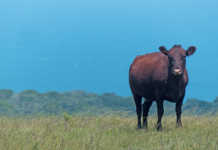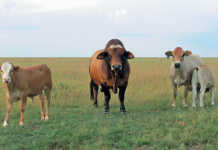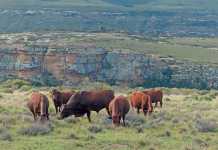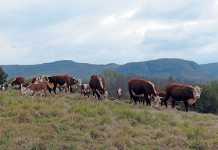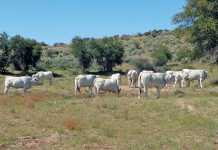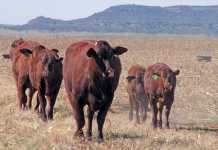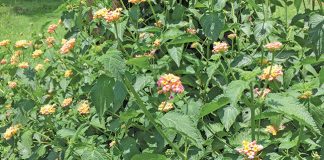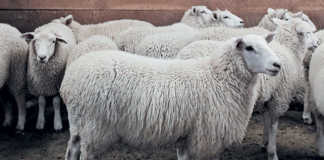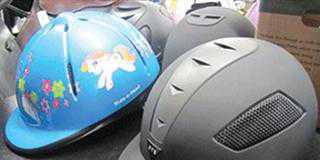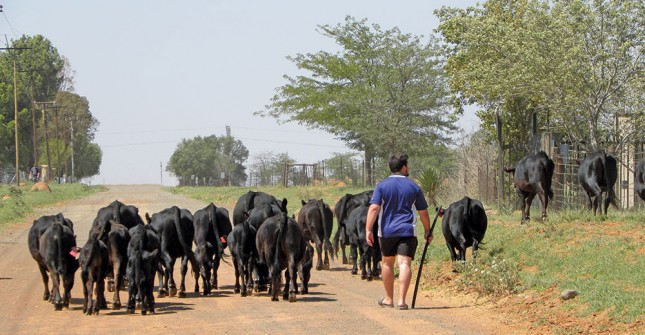
Photo: Chris Nel
The Dexter cattle breed is well established in South Africa. Often referred to as ‘beefy little milkers’, these small-bodied cattle thrive in environments varying from semi-arid to subtropical, and in systems ranging from smallholdings to large extensive farms.
Its dual-purpose nature and strong maternal traits has assured the Dexter cow a role as foster mother for calves or lambs.
As a physically small breed, the Dexter is ideal for smallholders who want to produce milk, butter and cottage cheese, as well as meat for home consumption.
Boosted by the Back to the Land movement, Dexter cattle are also a source of manure for organic vegetable production. It is easily kept, handled and transported without the need for specialised vehicles or facilities.
In some places, like Namibia, Dexter cattle are farmed extensively in commercial beef operations. The Dexter has excellent potential for crossbreeding.
Zandu Dexter cattle stud operation
Johan (Daffie) Daffue, his wife Ansie and their son, Pieter, run their Zandu Dexter Stud on 8,56ha at Bloemdal, south of Bloemfontein.
They lease 50ha of grazing from neighbours whenever they need it, which provides them with a useful buffer in times of drought and forage scarcity.

Grazing resources consist of 56ha veld and 2ha irrigated pasture (lucerne and oats), fenced off into five camps.
The herd currently consists of 40 registered Dexter cattle – two bulls, 22 cows, 10 calves, seven weaners and eight replacement heifers. Animals are rotated through the camps in a single group, but are separated if necessary.
The Daffues also run a few commercial Dexter cattle, 40 Dorper-type sheep, four pigs, 16 geese and some farmyard chickens.
The Zandu Dexter stud was founded in 1998 with breeding stock obtained mainly from the Ebert, Pikini and Gavenid herds. It has since built up a solid reputation for excellence and high quality animals in the Dexter cattle community.
The Daffues participate in the National Beef Cattle Performance Improvement Scheme and are recognised for their sustained contribution to the breed and its society.
The Zandu Stud features prominently in shows, with many class winners and champions over the years to its credit.
Dexter cattle dairy production
Milk production is the main economic activity of the herd. Production during the 210-day lactation period averages between 5l and 8l.
“We milk all lactating cows by hand in the morning,” Daffie explains. “Neighbours and others are a ready cash market and we process surplus milk into butter, buttermilk and cheese.”
Calves are penned from 6pm and join their dams at 7am after morning milking for the rest of the day.
This gives them an 11-hour suckling period. At milking, every cow gets a bucket (5l) of milled lucerne and 1kg of meal.
Zandu Stud heifers calve down at 24 months, and produce between 4l and 5l milk a day in their first lactation.
“We handle them as we do the cows in terms of milking and calf care,” says Daffie.
Dexter cows are easy calvers and adapt their milk production according to demand.
“Not all Dexter owners milk their cows, and this has led to a few common misconceptions about the breed,” he adds.
A cow’s condition or body shape does not necessarily make her a ‘pure’ Dexter, he explains. Neither do looks and long legs give her a good udder or make her a good milker.
“In my experience, a cow weighing between 280kg and 300kg proportionally yields more milk that one weighing between 350kg to 450kg,” he adds.
A good Dexter cow has a well-formed, functional udder.
“The udder should be long, wide, of average depth, a continuation of the bottom line and carried well above the hocks. Width between the rear legs means a better udder attachment and an easier cow to milk.”
When the udder is full, the quarters should be well-balanced and symmetrical, and the rear attachment high and wide. Teats should be cylindrical and uniform in size and shape.
“They must be well-placed on the corners of the quarters, free-hanging at a comfortable spacing with a soft, supple and elastic feel. The udder must withdraw sufficiently after milking. Excessively prominent superficial venation in the udder is undesirable.”
The Zandu Dexter herd’s long-term (20+ years) average is about 4l/day. A ready local market and daily on farm collection makes milking a sustainable, profitable operation for the Daffues.

The bull Gavenid-Zandu Tobie MD 10 0014 was born on 11 August 2010 at a birth weight of 25kg. His weight on 2 February 2016 was 685kg. His dam was MDZ 00 41 and his sire was DG 06 001. This bull has an impressive show record and is also an approved AI bull.
The product
The Dexter milk’s fat globules are very small, so the milk is homogenous and readily digestible.
The cream separates easily for outstanding cream, butter, ice cream and other dairy products.
The A2 protein, present in Dexter milk, is preferable to the A1 protein found in the milk of other breeds.
Dexter cattle milk compares well with the milk of other dual-purpose breeds and even with that of pure dairy breeds, except for the absence of A1 protein in the milk of a pure Dexter. When the Dexter is crossed with a breed such as the Jersey, A1 protein is present in the milk of F1 cows.
Contact Johan, Ansie or Pieter Daffue on 082 338 5319 or [email protected].

